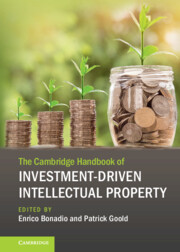Book contents
- The Cambridge Handbook of Investment-Driven Intellectual Property
- The Cambridge Handbook of Investment-Driven Intellectual Property
- Copyright page
- Contents
- Figures and Tables
- Contributors
- Foreword
- Introduction
- I Creativity, Pluralism, and Fictitious Narratives
- Part I Science, Technology and Industry
- II Sui Generis Protection of Non-creative Databases
- III Test Data Exclusivity
- IV Copyright in Works Created by Artificial Intelligence
- V Plant Variety Protection and Investment
- VI Software Protection under Copyright Law
- VII Bilski and the Information Age a Decade Later
- VIII Pharmaceutical Patents and Evergreening
- Part II Culture and Entertainment
- Part III Signs, Images and Designs
IV - Copyright in Works Created by Artificial Intelligence
Between Creativity and Investments
from Part I - Science, Technology and Industry
Published online by Cambridge University Press: 16 March 2023
- The Cambridge Handbook of Investment-Driven Intellectual Property
- The Cambridge Handbook of Investment-Driven Intellectual Property
- Copyright page
- Contents
- Figures and Tables
- Contributors
- Foreword
- Introduction
- I Creativity, Pluralism, and Fictitious Narratives
- Part I Science, Technology and Industry
- II Sui Generis Protection of Non-creative Databases
- III Test Data Exclusivity
- IV Copyright in Works Created by Artificial Intelligence
- V Plant Variety Protection and Investment
- VI Software Protection under Copyright Law
- VII Bilski and the Information Age a Decade Later
- VIII Pharmaceutical Patents and Evergreening
- Part II Culture and Entertainment
- Part III Signs, Images and Designs
Summary
Artificial intelligence (AI) has captured the attention of copyright lawyers fascinated by the thought of machines creating works of art, music and literature. There is no doubt that, as has often happened in the past during previous waves of technological advances, AI platforms – and especially, machine learning – have brought with them new opportunities as well as challenges. Machine learning is an AI application enabling programs to learn and progress automatically from experience. Its main feature is accessing data and often using it for the purpose of creating outputs, including music, literature, movies and art. Amounts of data are observed and analysed by the machine, which enables the latter to learn and then make creative decisions leading to final outputs that, as precise works of art, are often not foreseeable by the people who developed and started the initial program. Such a process is characterised by the absence of substantial human intervention or assistance after the program is operated, and by using algorithms – namely a sequence of instructions aimed at solving a problem or performing a computation. This can be labelled ‘algorithmic creativity’, that is, the way by which AI creates new works.
Information
- Type
- Chapter
- Information
- Publisher: Cambridge University PressPrint publication year: 2023
